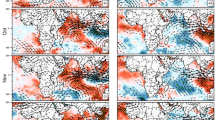Abstract
The extratropical response to tropical remote forcing has been examined with so-called tropical ocean-global atmosphere experiments, which use prescribed sea surface temperature (SST) in the tropical Pacific and a slab mixed-layer ocean model elsewhere. In this study we have revisited this experimental design and found that the extratropical response is quite sensitive to the meridional extent of tropical prescribed SST domain. Even in the case of a prescribed annual cycle only (i.e., no ENSO), the differences in the prescribed SST regions lead to different atmospheric motions in the adjacent extratropics. When the tropical forcing includes ENSO, the sensitivity to the meridional domain is more prominent, especially during La Niña events. In La Niña, the prescribed SST is warmer than the simulated SST in the northern subtropics, and the warmer SST differences continue to 30°N. This broad SST differences accompany enhanced atmospheric meridional circulation that directly connects the tropics and extratropics within the Pacific basin. Moreover, the Rossby wave excitation also increases, so the effect of prescribed region difference is felt beyond the Pacific basin. On the other hand, the effect of ENSO sea surface temperature anomalie (i.e., ENSO experiment composite minus control experiment annual cycle, both of which have the same prescribed SST domain) is stronger in the broad tropical forcing experiment. However, the ENSO anomaly composite from own annual cycle is similar regardless of the meridional extent of forcing region, and commonly mimics the Northern Hemisphere El Niño composite of nature in the boreal winter season.











Similar content being viewed by others
Notes
The F test indicates that the variance of the M20C experiment around Antarctica is significantly larger than that of the M10C experiment (not shown) so we need to be cautious in interpreting the t test results.
The NCAR CCSM3 Slab Ocean Control data is obtained from the World Climate Research Programme’s (WCRP’s) Coupled Model Intercomparison Project phase 3 (CMIP3) multi-model dataset. The resolution of CCSM3 is T85.
The NCAR CAM3 AMIP data is obtained from WCRP’s CMIP3 multi-model dataset. Because the model data is only available from January 1978 to December 2000, four El Niño and four La Niña events in this period are used for the composite analysis. The resolution of CAM3 is T85.
References
Alexander MA, Blade I, Newman M, Lanzante JR, Lau N-C, Scott JD (2002) The atmospheric bridge: the influence of ENSO teleconnections on air-sea interaction over the global oceans. J Clim 15:2205–2231. doi:10.1175/1520-0442(2002)015<2205:TABTIO>2.0.CO;2
Collins WD, Rasch PJ, Boville BA, Hack JJ, McCaa JR, Williamson DL, Briegleb BP (2006) The formulation and atmospheric simulation of the Community Atmosphere Model Version 3 (CAM3). J Clim 19:2144–2161. doi:10.1175/JCLI3760.1
Hoskins BJ, Karoly DJ (1981) The steady linear response of a spherical atmosphere to thermal and orographic forcing. J Atoms Sci 38:1179–1196. doi:10.1175/1520-0469(1981)038<1179:TSLROA>2.0.CO;2
Hoskins BJ, Simmons AJ, Andrews DG (1977) Energy dispersion in a barotropic atmosphere. Q J R Meteorol Soc 103:553–568. doi:10.1002/qj.49710343802
Jin D, Kirtman BP (2009) The impact of ENSO periodicity on North Pacific SST variability. Clim Dyn (in press)
Kalnay E et al (1996) The NCEP/NCAR 40-Year Reanalysis Project. Bull Am Meteorol Soc 77:437–471. doi:10.1175/1520-0477(1996)077<0437:TNYRP>2.0.CO;2
Kiehl JT, Hack JJ, Bonan GB, Boville BB, Williamson DL, Rasch PJ (1998) The National Center for Atmospheric Research Community Climate Model: CCM3. J Clim 11:1131–1149. doi:10.1175/1520-0442(1998)011<1131:TNCFAR>2.0.CO;2
Kumar A, Hoerling MP (2003) The nature and causes for the delayed atmospheric response to El Nino. J Clim 16:1391–1403. doi:10.1175/2771.1
Lau N-C (1997) Interaction between global SST anomalies and the midlatitude atmospheric circulation. Bull Am Meteorol Soc 78:21–33. doi:10.1175/1520-0477(1997)078<0021:IBGSAA>2.0.CO;2
Lau N-C, Nath MJ (1994) A modeling study of the relative roles of tropical and extratropical SST anomalies in the variability of the global atmosphere–ocean system. J Clim 7:1184–1207. doi:10.1175/1520-0442(1994)007<1184:AMSOTR>2.0.CO;2
Lau N-C, Nath MJ (1996) The role of the “Atmospheric Bridge” in linking tropical Pacific ENSO events to extratropical SST anomalies. J Clim 9:2036–2057. doi:10.1175/1520-0442(1996)009<2036:TROTBI>2.0.CO;2
Lau N-C, Nath MJ (2001) Impact of ENSO on SST variability in the North Pacific and North Atlantic: Seasonal dependence and role of extratropical sea-air coupling. J Clim 14:2846–2866. doi:10.1175/1520-0442(2001)014<2846:IOEOSV>2.0.CO;2
Lau N-C, Nath MJ (2003) Atmosphere-ocean variations in the Indo-Pacific sector during ENSO episodes. J Clim 16:3–20. doi:10.1175/1520-0442(2003)016<0003:AOVITI>2.0.CO;2
Lau N-C, Leetmaa A, Nath MJ (2005) Influences of ENSO-induced Indo-western Pacific SST anomalies on extratropical atmospheric variability during the boreal summer. J Clim 18:2922–2942. doi:10.1175/JCLI3445.1
Liu Z, Alexander M (2007) Atmospheric bridge, oceanic tunnel, and global climatic teleconnections. Rev. of Geophys. 45:2005RG00172
Rayner NA, Parker DE, Frich P, Horton EB, Folland CK, Alexander LV (2000) SST and sea-ice fields for ERA40. In: Proceedings of the second WCRP international conference on reanalyses. World climate research program, Wokefield Park, Reading, United Kingdom, p 18–21
Seager R, Kushinir Y, Herweijer C, Naik N, Velez J (2005) Modeling of tropical forcing of persistent droughts and pluvials over western North America: 1856–2000. J Clim 18:4065–4088. doi:10.1175/JCLI3522.1
Straus D, Shukla J (2002) Does ENSO force the PNA? J Clim 15:2340–2358. doi:10.1175/1520-0442(2002)015<2340:DEFTP>2.0.CO;2
Acknowledgments
This manuscript is a part of George Mason University Ph.D. dissertation of DJ. DJ would like to thank dissertation committee members, Professor Tim DelSole, Edwin Schneider, and David Straus for comments and suggestions on the manuscript. We also thank two anonymous reviewers for improving the first draft of this paper. BPK acknowledges support from NOAA grants NA17RJ1226, NA080AR4320889 and NSF grants OCI0749165 and ATM0754341.
Author information
Authors and Affiliations
Corresponding author
Rights and permissions
About this article
Cite this article
Jin, D., Kirtman, B.P. The extratropical sensitivity to the meridional extent of tropical ENSO forcing. Clim Dyn 34, 935–951 (2010). https://doi.org/10.1007/s00382-009-0600-1
Received:
Accepted:
Published:
Issue Date:
DOI: https://doi.org/10.1007/s00382-009-0600-1




